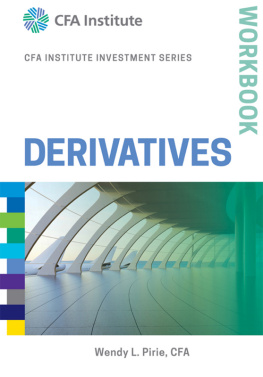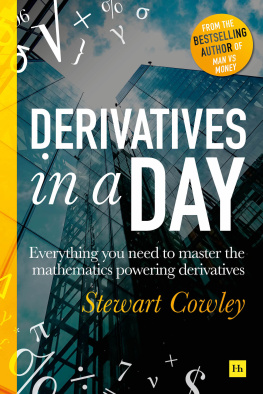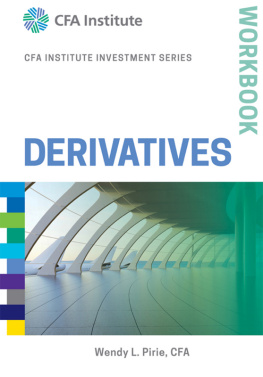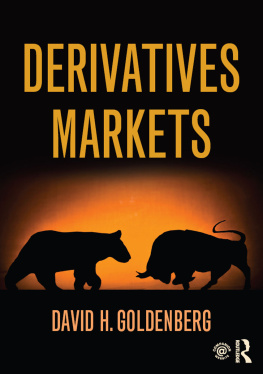
CFA Institute is the premier association for investment professionals around the world, with over 142,000 members in 159 countries. Since 1963 the organization has developed and administered the renowned Chartered Financial Analyst Program. With a rich history of leading the investment profession, CFA Institute has set the highest standards in ethics, education, and professional excellence within the global investment community, and is the foremost authority on investment profession conduct and practice. Each book in the CFA Institute Investment Series is geared toward industry practitioners along with graduate-level finance students and covers the most important topics in the industry. The authors of these cutting-edge books are themselves industry professionals and academics and bring their wealth of knowledge and expertise to this series.
Cover image: AvDe/Shutterstock
Cover design: Wiley
Copyright 2017 by CFA Institute. All rights reserved.
Published by John Wiley & Sons, Inc., Hoboken, New Jersey.
Published simultaneously in Canada.
No part of this publication may be reproduced, stored in a retrieval system, or transmitted in any form or by any means, electronic, mechanical, photocopying, recording, scanning, or otherwise, except as permitted under Section 107 or 108 of the 1976 United States Copyright Act, without either the prior written permission of the Publisher, or authorization through payment of the appropriate per-copy fee to the Copyright Clearance Center, Inc., 222 Rosewood Drive, Danvers, MA 01923, (978) 750-8400, fax (978) 646-8600, or on the Web at www.copyright.com. Requests to the Publisher for permission should be addressed to the Permissions Department, John Wiley & Sons, Inc., 111 River Street, Hoboken, NJ 07030, (201) 748-6011, fax (201) 748-6008, or online at http://www.wiley.com/go/permissions.
Limit of Liability/Disclaimer of Warranty: While the publisher and author have used their best efforts in preparing this book, they make no representations or warranties with respect to the accuracy or completeness of the contents of this book and specifically disclaim any implied warranties of merchantability or fitness for a particular purpose. No warranty may be created or extended by sales representatives or written sales materials. The advice and strategies contained herein may not be suitable for your situation. You should consult with a professional where appropriate. Neither the publisher nor author shall be liable for any loss of profit or any other commercial damages, including but not limited to special, incidental, consequential, or other damages.
For general information on our other products and services or for technical support, please contact our Customer Care Department within the United States at (800) 762-2974, outside the United States at (317) 572-3993 or fax (317) 572-4002.
Wiley publishes in a variety of print and electronic formats and by print-on-demand. Some material included with standard print versions of this book may not be included in e-books or in print-on-demand. If this book refers to media such as a CD or DVD that is not included in the version you purchased, you may download this material at http://booksupport.wiley.com. For more information about Wiley products, visit www.wiley.com.
ISBN 9781119381839 (Paperback)
ISBN 9781119381907 (ePDF)
ISBN 9781119381785 (ePub)
PART I
LEARNING OBJECTIVES, SUMMARY OVERVIEW, AND PROBLEMS
CHAPTER 1
DERIVATIVE MARKETS AND INSTRUMENTS
LEARNING OUTCOMES
After completing this chapter, you will be able to do the following:
- define a derivative and distinguish between exchange-traded and over-the-counter derivatives;
- contrast forward commitments with contingent claims;
- define forward contracts, futures contracts, options (calls and puts), swaps, and credit derivatives and compare their basic characteristics;
- describe purposes of, and controversies related to, derivative markets;
- explain arbitrage and the role it plays in determining prices and promoting market efficiency.
SUMMARY OVERVIEW
This first reading on derivatives introduces you to the basic characteristics of derivatives, including the following points:
- A derivative is a financial instrument that derives its performance from the performance of an underlying asset.
- The underlying asset, called the underlying, trades in the cash or spot markets and its price is called the cash or spot price.
- Derivatives consist of two general classes: forward commitments and contingent claims.
- Derivatives can be created as standardized instruments on derivatives exchanges or as customized instruments in the over-the-counter market.
- Exchange-traded derivatives are standardized, highly regulated, and transparent transactions that are guaranteed against default through the clearinghouse of the derivatives exchange.
- Over-the-counter derivatives are customized, flexible, and more private and less regulated than exchange-traded derivatives, but are subject to a greater risk of default.
- A forward contract is an over-the-counter derivative contract in which two parties agree that one party, the buyer, will purchase an underlying asset from the other party, the seller, at a later date and at a fixed price they agree upon when the contract is signed.
- A futures contract is similar to a forward contract but is a standardized derivative contract created and traded on a futures exchange. In the contract, two parties agree that one party, the buyer, will purchase an underlying asset from the other party, the seller, at a later date and at a price agreed on by the two parties when the contract is initiated. In addition, there is a daily settling of gains and losses and a credit guarantee by the futures exchange through its clearinghouse.
- A swap is an over-the-counter derivative contract in which two parties agree to exchange a series of cash flows whereby one party pays a variable series that will be determined by an underlying asset or rate and the other party pays either a variable series determined by a different underlying asset or rate or a fixed series.
- An option is a derivative contract in which one party, the buyer, pays a sum of money to the other party, the seller or writer, and receives the right to either buy or sell an underlying asset at a fixed price either on a specific expiration date or at any time prior to the expiration date.
- A call is an option that provides the right to buy the underlying.
- A put is an option that provides the right to sell the underlying.
- Credit derivatives are a class of derivative contracts between two parties, the credit protection buyer and the credit protection seller, in which the latter provides protection to the former against a specific credit loss.
- A credit default swap is the most widely used credit derivative. It is a derivative contract between two parties, a credit protection buyer and a credit protection seller, in which the buyer makes a series of payments to the seller and receives a promise of compensation for credit losses resulting from the default of a third party.
- An asset-backed security is a derivative contract in which a portfolio of debt instruments is assembled and claims are issued on the portfolio in the form of tranches, which have different priorities of claims on the payments made by the debt securities such that prepayments or credit losses are allocated to the most-junior tranches first and the most-senior tranches last.
- Derivatives can be combined with other derivatives or underlying assets to form hybrids.
Next page






